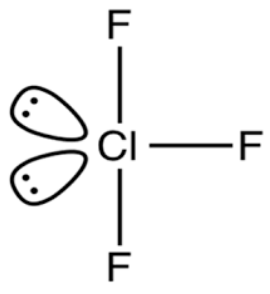
Which of the following molecules is of T-shape?
(A) $ {{I}_{3}}. $
(B) $ Cl{{F}_{3}}. $
(C) $ S{{F}_{4}} $
(D) $ Xe{{F}_{4}} $
Answer
515.4k+ views
Hint: We know that the valence shell electron pair repulsion (VSEPR) theory is used to determine the shape of molecules. According to VSEPR theory the lone pair-lone pair has the maximum repulsion followed by the bond pair-lone pair and bond pair –bond pair. In $ Cl{{F}_{3}} $ two lone pairs are placed in an axial plane which minimizes the repulsion and stabilizes the molecule.
Complete answer:
In, the chlorine is a central atom. The electronic configuration of chlorine atom is as: $ Cl=1{{s}^{2}}2{{s}^{2}}2{{p}^{6}}3{{s}^{2}}3{{p}^{5}}. $
Chlorine atom has seven valence electrons. In molecules, the central chlorine atom is surrounded by three fluorine atoms. Each fluorine atom shares one electron with chlorine atom and results in three covalent $ Cl-F $ bonds. The $ Cl{{F}_{3}} $ molecule has $ 7 $ valence electrons from chlorine and three from Fluorine. Thus there are a total $ 10 $ electrons around the central chlorine atom. Now let’s determine the electron pair in $ Cl{{F}_{3}} $ molecule. Divide the total number of electrons by $ 2. $
There are a total of five electron pairs in molecules. Let’s calculate the number of lone pairs in the molecule. The lone pair of electrons can be determined by subtraction of the number of bond pairs from the electron pair.

Therefore, the correct answer is option B.
Note:
Remember that while drawing the structures for different molecule types; always highlight the lone pairs to easily calculate the number of lone pairs. Remember that the shape and geometry of a molecule are not always the same. When lone pairs are present, the shape of the molecule is different from the geometry of the molecule.
Complete answer:
In, the chlorine is a central atom. The electronic configuration of chlorine atom is as: $ Cl=1{{s}^{2}}2{{s}^{2}}2{{p}^{6}}3{{s}^{2}}3{{p}^{5}}. $
Chlorine atom has seven valence electrons. In molecules, the central chlorine atom is surrounded by three fluorine atoms. Each fluorine atom shares one electron with chlorine atom and results in three covalent $ Cl-F $ bonds. The $ Cl{{F}_{3}} $ molecule has $ 7 $ valence electrons from chlorine and three from Fluorine. Thus there are a total $ 10 $ electrons around the central chlorine atom. Now let’s determine the electron pair in $ Cl{{F}_{3}} $ molecule. Divide the total number of electrons by $ 2. $
There are a total of five electron pairs in molecules. Let’s calculate the number of lone pairs in the molecule. The lone pair of electrons can be determined by subtraction of the number of bond pairs from the electron pair.

Therefore, the correct answer is option B.
Note:
Remember that while drawing the structures for different molecule types; always highlight the lone pairs to easily calculate the number of lone pairs. Remember that the shape and geometry of a molecule are not always the same. When lone pairs are present, the shape of the molecule is different from the geometry of the molecule.
Recently Updated Pages
Why are manures considered better than fertilizers class 11 biology CBSE

Find the coordinates of the midpoint of the line segment class 11 maths CBSE

Distinguish between static friction limiting friction class 11 physics CBSE

The Chairman of the constituent Assembly was A Jawaharlal class 11 social science CBSE

The first National Commission on Labour NCL submitted class 11 social science CBSE

Number of all subshell of n + l 7 is A 4 B 5 C 6 D class 11 chemistry CBSE

Trending doubts
Differentiate between an exothermic and an endothermic class 11 chemistry CBSE

10 examples of friction in our daily life

One Metric ton is equal to kg A 10000 B 1000 C 100 class 11 physics CBSE

Difference Between Prokaryotic Cells and Eukaryotic Cells

1 Quintal is equal to a 110 kg b 10 kg c 100kg d 1000 class 11 physics CBSE

State the laws of reflection of light




